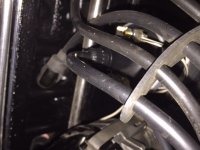CJD
Yoda
Offline
Yesterday I did the annual tune up on the TR3A. Even after R&R'ing the entire car, I learned something new. When I took the high tension coil wire off the coil, it had a simple press-in connector in the end of the wire, with a rubber sealing cap around it. Just like when I bought the car, and just like when I finished the restoration.
I went to spread the press-in connector for a tight fit in the coil, and realized something was not right. Well, having worked on the TR2, I now know what a screw in coil looks like...and it turns out the TR3A has one! All that has been holding the coil wire in for at least 3 decades is the friction of the little rubber cap.
Guess the old girl was jealous that all the parts were going to the TR2. This will be the first part I'll have to find for the TR3 in over 3 years!
I went to spread the press-in connector for a tight fit in the coil, and realized something was not right. Well, having worked on the TR2, I now know what a screw in coil looks like...and it turns out the TR3A has one! All that has been holding the coil wire in for at least 3 decades is the friction of the little rubber cap.
Guess the old girl was jealous that all the parts were going to the TR2. This will be the first part I'll have to find for the TR3 in over 3 years!

 Hi Guest!
Hi Guest!

 smilie in place of the real @
smilie in place of the real @
 Pretty Please - add it to our Events forum(s) and add to the calendar! >>
Pretty Please - add it to our Events forum(s) and add to the calendar! >> 
